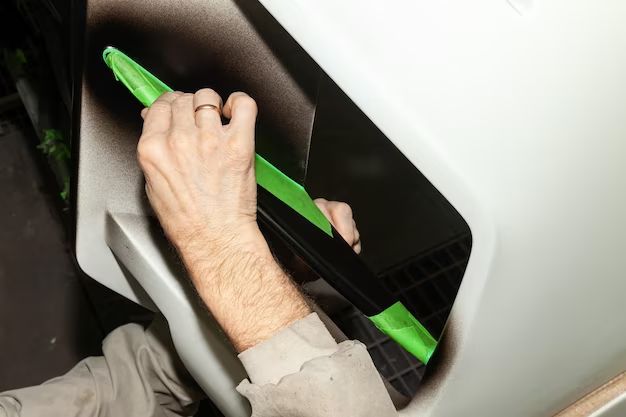When it comes to choosing the best adhesive for vehicle trim, you’ll need to consider a few key factors. The main requirements for an automotive trim adhesive are strength, flexibility, and durability in a wide range of temperatures and conditions. In this article, we’ll go over the pros and cons of the most common trim adhesives to help you pick the right one for your project.
Page Contents
Types of Adhesives for Vehicle Trim
There are three main types of adhesives used for attaching automotive interior and exterior trim:
- Acrylic adhesives
- Butyl adhesives
- Polyurethane adhesives
Each has its own strengths and ideal applications. Here’s an overview:
Acrylic Adhesives
Acrylic adhesives cure through solvent evaporation to form a strong plastic bond. They come in one-part and two-part formulas. Some key properties:
- Fast curing time
- Good gap-filling abilities
- Paintable
- Range of viscosity options
- Good UV resistance
- Lower temperature resistance than butyls and urethanes
Acrylics work well for bonding trim pieces like side moldings, emblems, door handles, and other exterior parts. Popular trade names include 3M Automotive Attachment Tape and Permatex Acrylic Adhesive.
Butyl Adhesives
Butyl adhesives are known for flexibility and tenacious bonding. Common types include:
- Non-curing butyls
- Curing polyisobutylenes (PIBs)
- Modified silane polymer (MS polymer) butyls
Key properties of butyl adhesives:
- Very good adhesion to many substrates
- Seal out water, dust, and noise
- Remain flexible across a wide temperature range
- Good gap-filling capacity
- Slow curing time
Butyls are a popular choice for bonding automotive glass into frames, as well as body side moldings, wheel well liners, bumper tabs, and other interior trim pieces.
Polyurethane Adhesives
Polyurethane (PU) adhesives offer a balance of strength, flexibility, and temperature resistance. They come as one-part moisture-cure or two-part formulations. Benefits include:
- Very strong yet flexible bonds
- Excellent adhesion to many materials
- Withstand extreme temperatures
- Vibration damping
- Range of curing speeds
Polyurethanes work well for bonding materials like plastics, composites, and metals. In auto trim applications, they’re used for headliners, carpeting, interior panels, and exterior trim moldings.
Factors in Choosing a Trim Adhesive
With the basics covered, here are some key factors to consider when selecting an adhesive for your vehicle trim project:
1. Substrates Being Bonded
Consider what materials you are bonding – is it plastic, metal, glass, composite, foam, etc? Some adhesives work better with certain substrates. For example, urethanes bond well to plastics while butyls adhere better to glass.
2. Permanence Needed
Will the trim be permanently installed or temporarily attached? Permanent bonds call for adhesives like urethanes and acrylics. Temporary or removable bonds can utilize lower strength adhesives like peel-and-stick butyl tape.
3. Environmental Exposure
Exterior trim will experience temperature swings, moisture, and UV exposure. An adhesive like urethane or acrylic holds up better to these elements long-term versus interior-use adhesives.
4. Production Speed
In auto assembly lines, fast cure adhesives like acrylics allow workers to quickly install trim pieces one after another. Slower curing products like butyls and two-part urethanes require more time between steps.
5. Gap Filling
Larger bond gaps require an adhesive with good gap-fill capacity, such as butyl tape or thick acrylic glue. Smaller, tighter gaps need low-viscosity adhesives that easily spread into the spaces.
6. Noise Damping
Adding foam-like butyl adhesive reduces road noise from entering the cabin. Acrylics and urethanes do not provide the same sound damping effect.
7. Appearance
For visible exterior trim, opt for an adhesive that won’t yellow, ooze out, or leave visible residue. Acrylics and urethanes offer cleaner appearances than butyls.
Top Adhesive Picks by Application
Given the factors above, here are some top recommendations for vehicle trim adhesive types by usage:
Exterior Trim
- 1st Choice: Polyurethane
- 2nd Choice: Acrylic
Polyurethanes and acrylics resist weathering better than butyls on exterior pieces like side moldings, mirror housings, and emblems.
Interior Trim
- 1st Choice: Butyl
- 2nd Choice: Polyurethane
For headliners, door panels, carpets, and other interior parts, flexible and damping butyl adhesives or strong polyurethanes work well.
Glass Bonding
- 1st Choice: Butyl
- 2nd Choice: Polyurethane
Butyl tapes and sealants make the best auto glass adhesives to prevent leaks, resist vibration, and allow glass removal if needed.
Plastics
- 1st Choice: Polyurethane
- 2nd Choice: Acrylic
For plastic trim parts, polyurethanes bond strongly while staying flexible on plastic’s expansion and contraction.
Metals
- 1st Choice: Polyurethane
- 2nd Choice: Acrylic
Metals require adhesives with rigid, secure bonds, making polyurethanes and acrylics good choices.
Pro Tips for Using Vehicle Trim Adhesives
Once you’ve selected the best adhesive type for your project, follow these pro tips to ensure optimal bonds:
- Thoroughly clean and prep bonding surfaces – remove dirt, oils, old adhesive, etc. for maximum adhesion.
- Use adhesion promoters on plastics and paints to improve glue bonding.
- Apply adhesive evenly across the entire bonding area.
- Secure parts with clamps or tape to prevent movement while curing.
- Follow cure times – don’t stress bonds before fully cured.
- Store adhesives properly by resealing containers and avoiding temperature extremes.
Conclusion
When selecting an automotive trim adhesive, consider the substrates, environment, production speed, appearance, and other factors needing the right balance of strength, flexibility, and durability. For most applications, polyurethanes, butyls, and acrylics make the best and most common choices.
Match your specific trim bonding needs to the adhesive properties. Then properly prepare surfaces and allow for full cure time. With the right glue and application, you can install vehicle trim that both looks great and lasts.
